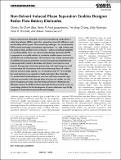| dc.contributor.author | Wan, Charles Tai-Chieh | |
| dc.contributor.author | Jacquemond, Rémy Richard | |
| dc.contributor.author | Chiang, Yet-Ming | |
| dc.contributor.author | Nijmeijer, Kitty | |
| dc.contributor.author | Brushett, Fikile R | |
| dc.contributor.author | Forner-Cuenca, Antoni | |
| dc.date.accessioned | 2021-10-27T19:52:43Z | |
| dc.date.available | 2021-10-27T19:52:43Z | |
| dc.date.issued | 2021 | |
| dc.identifier.uri | https://hdl.handle.net/1721.1/133413 | |
| dc.description.abstract | © 2020 The Authors. Advanced Materials published by Wiley-VCH GmbH. Porous carbonaceous electrodes are performance-defining components in redox flow batteries (RFBs), where their properties impact the efficiency, cost, and durability of the system. The overarching challenge is to simultaneously fulfill multiple seemingly contradictory requirements—i.e., high surface area, low pressure drop, and facile mass transport—without sacrificing scalability or manufacturability. Here, non-solvent induced phase separation (NIPS) is proposed as a versatile method to synthesize tunable porous structures suitable for use as RFB electrodes. The variation of the relative concentration of scaffold-forming polyacrylonitrile to pore-forming poly(vinylpyrrolidone) is demonstrated to result in electrodes with distinct microstructure and porosity. Tomographic microscopy, porosimetry, and spectroscopy are used to characterize the 3D structure and surface chemistry. Flow cell studies with two common redox species (i.e., all-vanadium and Fe2+/3+) reveal that the novel electrodes can outperform traditional carbon fiber electrodes. It is posited that the bimodal porous structure, with interconnected large (>50 µm) macrovoids in the through-plane direction and smaller (<5 µm) pores throughout, provides a favorable balance between offsetting traits. Although nascent, the NIPS synthesis approach has the potential to serve as a technology platform for the development of porous electrodes specifically designed to enable electrochemical flow technologies. | |
| dc.language.iso | en | |
| dc.publisher | Wiley | |
| dc.relation.isversionof | 10.1002/adma.202006716 | |
| dc.rights | Creative Commons Attribution 4.0 International license | |
| dc.rights.uri | https://creativecommons.org/licenses/by/4.0/ | |
| dc.source | Wiley | |
| dc.title | Non‐Solvent Induced Phase Separation Enables Designer Redox Flow Battery Electrodes | |
| dc.type | Article | |
| dc.contributor.department | Massachusetts Institute of Technology. Department of Chemical Engineering | |
| dc.contributor.department | Massachusetts Institute of Technology. Department of Materials Science and Engineering | |
| dc.relation.journal | Advanced Materials | |
| dc.eprint.version | Final published version | |
| dc.type.uri | http://purl.org/eprint/type/JournalArticle | |
| eprint.status | http://purl.org/eprint/status/PeerReviewed | |
| dc.date.updated | 2021-06-09T15:44:37Z | |
| dspace.orderedauthors | Wan, CT-C; Jacquemond, RR; Chiang, Y-M; Nijmeijer, K; Brushett, FR; Forner-Cuenca, A | |
| dspace.date.submission | 2021-06-09T15:44:39Z | |
| mit.journal.volume | 33 | |
| mit.journal.issue | 16 | |
| mit.license | PUBLISHER_CC | |
| mit.metadata.status | Authority Work and Publication Information Needed | |
